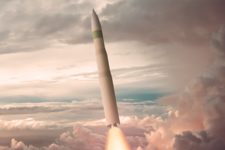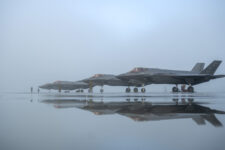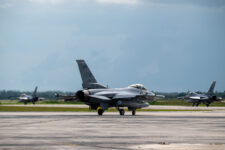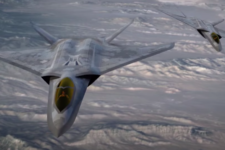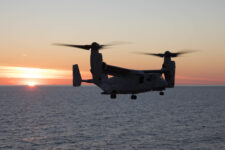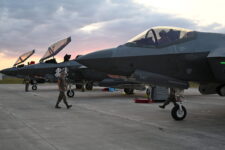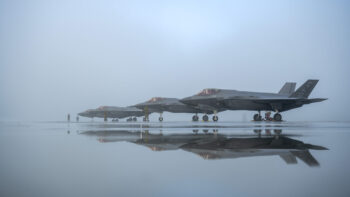
A model of Anduril’s Fury multi-mission Group 5 autonomous air vehicle. (Brendon Smith/Breaking Defense.)
WASHINGTON — The Air Force will show off full-scale models of two autonomous combat drones next week during its flagship conference, the service’s top official said Tuesday.
“If you come to the Air Force Association meeting next week, you’ll see two full scale models of the aircraft that we’re building: the first increment of uncrewed collaborative combat aircraft,” Air Force Secretary Frank Kendall said at the Aerospace Summit today. “These will be loyal wingmen, and they will be controlled by a crewed fighter, either an F-35 in all likelihood or possibly NGAD [the future Next Generation Air Dominance fighter] when we define what NGAD is.”
Legacy drone maker General Atomics and defense startup Anduril beat out Northrop Grumman, Boeing and Lockheed Martin in April to win contracts to develop uncrewed wingmen as part of the first increment of the Air Force’s Collaborative Combat Aircraft program.
Both companies confirmed Kendall’s statement that they will have full scale models of their CCA offerings at the trade show.
Further, a source familiar with the conference’s plans told Breaking Defense that General Atomics will showcase an actual XQ-67 aircraft at its booth. A version of the company’s Gambit family of aircraft that General Atomics has said will form the basis of its CCA offering, the XQ-67 flew its first flight in February as part of the Air Force’s Off Board Sensing Station program, which is helping to prove out technologies associated with drone wingmen.
Anduril has said it is pitching its Fury drone for the CCA program.
Under their contracts, both General Atomics and Anduril will build prototype CCAs, which are set to fly next year. The Air Force will then determine in 2026 whether to start production of the drones developed by either or both of the vendors — or to potentially purchase CCAs from one of the companies previously eliminated from the program.
The Air Force has said it could buy upwards of a thousand CCAs over the course of the program, potentially buying multiple drone variants from different manufacturers to accomplish various missions.
RELATED: Air Force requests more money for drone wingmen effort
The service plans to spend “several billion dollars” on CCAs over the next five years, Kendall said, adding that the investment is indicative of the “enormous opportunities” the Air Force sees in incorporating autonomy and artificial intelligence, including technologies associated with machine learning, data analytics, pattern recognition and generative AI.
“Whether it’s just to improve efficiency in terms of how to generate certain documents or actually help us with automated decision making, planning, execution, etcetera, we just need to bring them in and adopt them to our needs quickly, if we can,” Kendall said.
Aaron Mehta in Washington contributed to this report.




